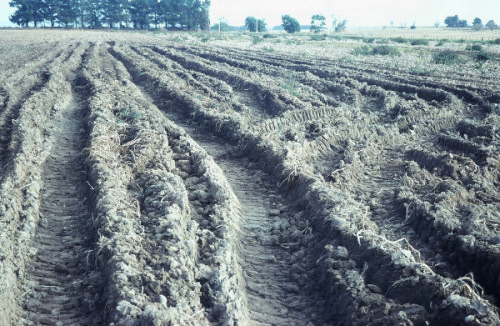|
|
Consequences of poor drainage
Poor germinationA poorly drained soil is essentially a late soil. In any soil the temperature must reach a critical level before germination can take place. The evaporation of excess moisture uses up specific heat of the soil and one which is badly drained will be slower to warm up than that of a well drained soil. This is why it is known as a late soil.
Traffic damagePoor drainage results in soils remaining moist and plastic for long periods increasing the risk of wheel slip and damage from tillage implements. Hence there are fewer opportunities for good ploughing, timely cultivations and good seed bed preparation etc. as a result these operations have to be carried out at times when the tackle used will cause serious damage to the soil structure. This is not readily apparent but the effects can last for a long time. This soil damage may also hinder or even prevent
germination.
Crop diseases
Diseases such as Mildew attack crops weakened by poor drainage conditions and we can often identify outbreaks of mildew in poppy crops in areas that have water stress problems. Club Root in brassicas, Foot Rot of leguminous plants and other diseases also flourish on wet land.
Poor response to fertilizers
The full benefits of fertilisers cannot be obtained on poorly drained soils. Root development and crop growth restricted by poor drainage lessens the response to fertilisers and some loss of nutrients will also occur. Fertilizer, labour, diesel, seed and irrigation is too costly to be applying to wet areas not to get a return at the end of the season.
DroughtCrops on poorly drained land form shallow rooting systems and consequently in dry periods they are unable to obtain sufficient moisture to maintain full growth and they rapidly show drought symptoms. This is clearly evident with pasture production where we see in well drained soils approximately two weeks earlier growth in spring and two to three weeks later growth in the autumn because the plants roots are deeper and able to hang on longer in spring and don’t wet up early in the autumn.
Patchy crops
Uneven crop growth can often be the result of varying drainage conditions. This is a frequent occurrence within a single field in many parts if the country. A field may have drainage problems in low places due to a high ground water level or an accumulation of surface water.
Harvesting problemsWhole crops such as potatoes can be lost because of the impossibility of getting the crops off badly drained land.
Restrictions on grazingOn wet land the growth of grass is severely retarded both at the beginning and the end of the grazing season because the soil temperature is lower than that of well drained land.
PuggingImpeded drainage produces conditions where grazing causes extensive pugging by stock damaging the soil structure in the upper layers. When this happens damage to the pasture is also extremely serious and its effects can last for a long time.
WeedsShallow rooting, surface creeping types of grasses and weeds thrive under poor drainage conditions pushing out the cultivated grasses and clovers. Soils waterlogged for long periods become infested by rushes and are normally very sour with a low pH
Difficulty in making silage or hayPoor drainage results in poor surface conditions for tractors and mowing machines, slowing down silage and hay making operations.
Animal diseasesFoot rot, flies, liver fluke etc thrive in badly drained areas. The liver fluke snail flourishes on wet land and the only sure way of preventing the disease is to destroy the snails’ habitat by draining the wet areas.
Root developmentIn soil with a well developed structure and good drainage root systems are able to develop to their fullest extent. On poorly structured wet land they will die back whilst a mass of fine roots at a shallow depth will indicate a barrier such as a water table, pan or structure less layer below.
Have you found any symptoms of the above?If one or more of the symptoms described on the previous pages are found it is a probable that your land does need draining.
|

